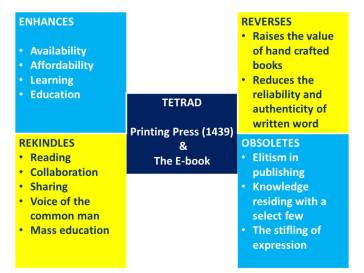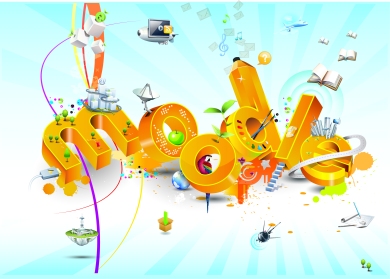Here is a sample Thinglink created for my readers.
Mouse over the image below and click on any of the highlighted points.
Here is a sample Thinglink created for my readers.
Mouse over the image below and click on any of the highlighted points.
Click on My Presentation to view media.
I can remember the days when my friends and I would save from our weekly lunch allowance in order to rent DVD’s on a Friday night. In those days we would congregate at Jude’s house to choose from the wide array of titles his parents offered to “rich” young kids and overworked adults seeking a cinematographic escape – all at a cost! We are a long way away from those kinds of experiences today. In fact, when I wanted to watch Total Recall (2012) recently, I simply brought it up on my mobile via the Netflix app.

 Every time I look at these forces that impact and affect technology emergence, I am convinced that there are no simple answers. In examining the DVD vs Video-On-Demand (VOD) phenomenon against Arthur’s (1996) increasing returns principle and the principle of red queens (Thornburg, 2014g), I am left with more questions than answers. Thornburg (2014g) defines the red queen in a way that is similar to his description of Arthurs increasing returns principle (Thornburg, 2014e). Both are described as the results of competition between two key or major technologies. The results of both have been described as having significant impact (Thornburg, 2014g). There’s an element in both principles that lends itself to chance or some unforeseen but impactful event or variable (something gives one or both an advantage). Both are vulnerable to the force of disruptive technologies (Louie, 2009; Stewart, 2012) and both forces bring about the obsolescence of some technology.
Every time I look at these forces that impact and affect technology emergence, I am convinced that there are no simple answers. In examining the DVD vs Video-On-Demand (VOD) phenomenon against Arthur’s (1996) increasing returns principle and the principle of red queens (Thornburg, 2014g), I am left with more questions than answers. Thornburg (2014g) defines the red queen in a way that is similar to his description of Arthurs increasing returns principle (Thornburg, 2014e). Both are described as the results of competition between two key or major technologies. The results of both have been described as having significant impact (Thornburg, 2014g). There’s an element in both principles that lends itself to chance or some unforeseen but impactful event or variable (something gives one or both an advantage). Both are vulnerable to the force of disruptive technologies (Louie, 2009; Stewart, 2012) and both forces bring about the obsolescence of some technology.

That said, I am left to decide if the battle between DVD and VOD is an example of increasing returns or red queens. Based on my own reflection I am going to go out on a limb and say it is both and it is neither. Arthur (1989) posits that “When two or more – increasing-return technologies ‘compete’ then, for a ‘market’ of potential adopters, insignificant events may by chance give one of them an initial advantage in adoptions(p. 116). I can definitely see this in the case of Netflix and Blockbusters. I can also make an informed decision that one “per chance” occurrence that tipped Netflix over the edge of success was the growing proliferation of smart devices. But take the case of Netflix vs Hulu and recognize how that rivalry pushed DVD use and sales to the edge of extinction (Spangler, 2016). This is exactly what Thornburg (2014g) describes as the red queen effect – as the competition between two technologies leave other competitors behind.

It is hard to look at the VOD/DVD competition without looking at other variables such as increase technological capability (when Netflix started it used DVDs) as well as changing consumer preferences and tastes. Satell (2014) even suggests that flawed business models played a significant role in the demise of the DVD industry. Despite that however one is able to see both forces at play (increasing returns and red queens) in this particular fight. And it is interesting to watch too as both technologies can easily fit in one of McLuhan’s tetrad analysis:
Tags: DVD, VOD, Video on demand, increasing returns, red queens, disruptive, tetrad, McLuhan,
References
Arthur, W. B. (1996). Increasing returns and the new world of business. Harvard business review, 74(4), 100-109.
Arthur, W. B. (1989). Competing technologies, increasing returns, and lock-in by historical events. The economic journal, 99(394), 116-131.
Laureate Education (Producer). (2014e). David Thornburg: Increasing returns [Video file]. Baltimore, MD: Author.
Laureate Education (Producer). (2014g). David Thornburg: Red queens [Video file]. Baltimore, MD: Author.
Louie, G. G. (2009). Persistent forecasting of disruptive technologies.
Satell, G. (2014). Forbes Welcome. Forbes.com. Retrieved from http://www.forbes.com/sites/gregsatell/2014/09/05/a-look-back-at-why-blockbuster-really-failed-and-why-it-didnt-have-to/#35774ac3261a
Spangler, T. (2016). The Slow Death of Redbox: Why the Kiosk Colossus Is the Next Blockbuster. Pmcvariety.files.wordpress.com. Retrieved from https://pmcvariety.files.wordpress.com/2016/02/redbox-failing.jpg?w=670&h=377&crop=1
Stewart, D. (2012). The Red Queen’s Deadly Effect on Innovation – Darin Stewart. Darin Stewart. Retrieved 4 November 2016, from http://blogs.gartner.com/darin-stewart/2012/08/06/the-red-queen-effect/
Thornburg, D. (2013d). Red queens, butterflies, and strange attractors: Imperfect lenses into emergent technologies. Lake Barrington, IL: Thornburg Center for Space Exploration.
For years, teachers in many Jamaican classrooms have struggled with how to view and to incorporate technology in the classroom (Virtue, 2015). To be frank, up until most recently, the only word most teachers would have used to describe modern electronic gadgets in the classroom is disruptive. It is that reality that makes this reflection such an experience of irony. In the space of this reflection, disruptive technologies in the classroom hold promise not dread; they represent possibilities not limitations, and they facilitate learning and not hinder it (Flavin, 2012).
Fonseca (2014) outlines that a disruptive technology is “ a new emerging technology that unexpectedly displaces an established one”. The potential power of disruptive technologies is captured by Radcliffe (2014), who describes disruptive technology as “technology that significantly alters the way that businesses operate. A disruptive technology may force companies to alter the way that they approach their business, risk losing market share or risk becoming irrelevant.” In a similar way, disruptive technologies like SixthSense have the power to alter the way the classroom operates.
SixthSense® is a wearable computer system that allows for seamless integration of and interaction between the physical environment and the world of digital information (Mistry, 2010). The interaction is facilitated through gesture-based movement with the aid of a small camera, projector, and mirror (Gupta and Sharma, 2012). This one-stop-shop technology displaces the need to have a cell phone, digital camera and a projector all at the same time. In the classroom it threatens the need for the laptop computer and creates a space where all these devices culminate in a not too large pendant around the neck.
From a constructivist perspective, where learning is a social construct (Kafai & Resnick, 1996), there are a number of social benefits to be derived from using SixthSense in the classroom. Kloucek (2010), cites benefits such as improved collaboration among students, greater levels of information sharing among teachers and students and improved relationship building as some of the immediate benefits of implementing SixthSense. Shetty & Rai (2014) have even suggested that the use of technology can facilitate greater levels of communication for persons who cannot speak. This has implication for the success of mixed abilities and differentiated classrooms. Because SixthSense allows of integration of digital and real-world experience it fosters interaction in a way that is apposite to the self-focussed tendencies of other current technology (Kloucek, 2010).
If ever a single technology had the potential of changing the leadership dynamic and the power relations in the classroom, then SixthSense would be it. The fact that all the basic 21st century teaching tools have been collapsed into one pendant that every student in a class can where around their neck, means that the students can fully take control of the learning experience. Through this technology students can fully own their learning and the teacher can take a true facilitatory role – guide on the side. They don’t even have responsibility of managing the technology used in the space.
It is difficult to say when and how SixthSense will be made obsolete. One of its challenges is that it has taken quite a long time to experience the kind or level of diffusion that technology like the multi-media projector enjoys in education. This makes SixthSense still an emerging technology, and that the makes risk of obsolescence high. In his video Disruptive Technologies, Dr David Thornburg recounts how transistor technology replaced the vacuum tube forever. The same is possible for SixthSense if more is not done to facilitate its full emergence. All in all, I say my own sixth sense gives SixthSense approximately five more years on the market.
Gupta, M., & Sharma, S. (2012). Virtual Class room using six sense Technology. IOSR Journal of Computer Engineering (IOSRJCE) Volume, 6.
Flavin, M. (2012). Disruptive technologies in higher education. Research in Learning Technology, 20.
Fonseca, M. (2014). Disruptive Technology Examples: 12 Of The Best Disruptive Technologies. Intelligent Head Quarters. Retrieved 21 October 2016, from http://www.intelligenthq.com/technology/12-disruptive-technologies/
Kafai, Y. B., & Resnick, M. (1996). Constructionism in practice: Designing, thinking, and learning in a digital world. Routledge.
Kloucek, T. (2010). SixthSense for the Classroom by Tom Kloucek. YouTube. Retrieved from https://www.youtube.com/watch?v=l7VWYFZCEjg
Laureate Education (Producer). (2014a). David Thornburg: Disruptive technologies [Video file]. Baltimore,MD: Author.
Mistry, P. (2010). SixthSense – a wearable gestural interface (MIT Media Lab). Pranavmistry.com. Retrieved from http://www.pranavmistry.com/projects/sixthsense/
Mooneegan, V. (2016). Technology Disruption | Vidia Mooneegan | TEDxPlainesWilhems. YouTube. Retrieved from https://www.youtube.com/watch?v=pk9RVBwiFbM
Radcliffe, B. (2014). Disruptive Technology. Investopedia. Retrieved from http://www.investopedia.com/terms/d/disruptive-technology.asp
TED India. (Producer). (2009). The thrilling potential of SixthSense technology [Video file]. Retrieved from http://www.ted.com/talks/pranav_mistry_the_thrilling_potential_of_sixthsense_technology.html
Virtue, E. (2015, July 26). Schools Ponder Cell Phone Policy! The Gleaner. Retrieved from http://jamaica-gleaner.com/article/news/20150726/schools-ponder-cell-phone-policy
Nino Varsimashvili is credited with the words “life is the muse which perfectly rhymes…”
As I reflect of technology emergence, I must say I am pleased with the progress I am making through this course. I am recognizing that technology emergence is driven by a number of complementary and sometimes opposing forces that must be considered when there is any reflection on or prediction on emergence. One of those forces is that of the rhyme of history.
When the impact of a new technology revives or reawakens something from the distant past, we refer to that as a rhyme of history (Laureate Education, 2014h). This phenomenon is called a rhyme of history because of the way the “affect” of the technology resembles the kind of impact a technology from the past has had.
In the course Trends and Issues in Educational Technology, I learned that issues are borne out of problems, usually those recurring problems that mankind tend to continually innovate around. I am recognizing now that the rhymes of history, as a driving force for technology emergence, is itself fed by that need we have as human beings to address the issues of our times. The fact that, as humans we are basically the same, despite our differences (even differences in eras and generations), means that some of our problems are the same and some of our issues are the same. As a result the ways we try to resolve those issues, from generation to generation, will resemble each other – they will rhyme.
I am also recognizing that evolutionary force will push a technology into existence, but its impact will carry it along the emergence continuum.
Recently I was asked by a friend to make  a short presentation on the impact of the printing press on the society of 1439. In my quick research and analysis, I found the following impact:
a short presentation on the impact of the printing press on the society of 1439. In my quick research and analysis, I found the following impact:
As I reflected, I recognized glaring similarities with the e-book of today (Hillesund, 2001; Klaava”, 2016). So, you guessed it, I took out the tetrad (Laureate Education, 2014f) to further examine these two important technology breakthroughs. (See 2-in-1 tetrad above.)
For more on e-books check out:
http://klaava.com/books/gutenbergs-printing-press-revolutionized-book-business-just-like-ebooks-are-doing-now/
http://faze.ca/the-future-of-reading-e-books/
Reference
Ebook timeline. (2002). the Guardian. Retrieved from https://www.theguardian.com/books/2002/jan/03/ebooks.technology
Gutenberg’s printing press revolutionized book business just like ebooks are doing now | Klaava. (2016). Klaava.com. Retrieved from http://klaava.com/books/gutenbergs-printing-press-revolutionized-book-business-just-like-ebooks-are-doing-now/
Hillesund, T. (2001). Will E-books change the world?. First Monday, 6(10). Retrieved from http://firstmonday.org/ojs/index.php/fm/article/view/891/800
Laureate Education (Producer). (2014h). David Thornburg: Rhymes of history [Video file]. Baltimore, MD: Author.
Laureate Education (Producer). (2014f). David Thornburg: McLuhan’s Tetrad [Video file]. Baltimore, MD: Author.
The Gutenberg Galaxy. (2016). Google Books. Retrieved from https://books.google.com.jm/books?id=zFc5n4CbsbwC&printsec=frontcover&source=gbs_ge_summary_r&cad=0#v=onepage&q=crude&f=false
I was one of the relatively early adopters of cloud based services. For some time, I had had all my digitized data stored on a bunch of pocket/flash drives tied to a string. Then I lost it all. I mourned for weeks and it cost me some thousands of dollars on my bonus check that year as I lost critical evidence of work done. I walked away from that experience knowing that it was the last time I would interact with such technology. I have not used a flash drive devise in approximately eight years.

Cloud computing involves the storage of files on remote virtualized servers (Wickremasinghe, Calheiros, & Buyya, 2010, April). The concept has been around for some time but became very popular about 2005 (Timmermans, Stahl, Ikonen, & Bozdag, 2010). In using McLuhan’s tetrad (McLuhan & McLuhan, 1988) to analyse cloud technology, I have come to realize that the results of this kind of analysis is heavily dependent on the perspective from which the analysis is undertaken.
Lessons Learned
As I sat down to create my “cloud computing tetrad”, I realised that I had themes that could intertwine on one hand as well as could be grouped into categories on the other. As I created the three tetrads based on an analysis of the impact of could computing on storage, security and social welfare, I found that the tetrad encouraged critical thinking about the technology. I was also able to conceptualize one viable “spin-off” technology and look more deeply at the life impact of the technology. I was also able to see the potential for innovation opportunities in examining what a technology rekindles.

What Cloud Computing Enhances
The technology facilitates large scale digital storage (“Cloud Computing Tetrad”, 2016) with the capability of access management. Through the management of access and retrieval, cloud computing creates the space for collaboration on (“McLuhan’s Tetrad | Thoughts on Emerging and Future Technology”, 2016), and the sharing of, data and information. This is done within the context of flexibility, as individuals control when, where and how they collaborate with each other.
What Cloud Computing Obsoletes
The cloud in effect nullifies every kind of on-site storage system, from filing cabinets to flash drives. It eliminates the number of back-up storage devices formally utilized to secure data and removes the pressure of working alone through collaboration capabilities.
What Cloud Computing Rekindles
 Apart from revitalizing concepts such as community, collaboration and team work(“McLuhan’s Tetrad | Thoughts on Emerging and Future Technology”, 2016), cloud computing helps persons to regain control over personal data and re-establishes a sense of security regarding such data. It also re-introduces the hoarding of data and information as persons are able to store massive amounts of digitized files.
Apart from revitalizing concepts such as community, collaboration and team work(“McLuhan’s Tetrad | Thoughts on Emerging and Future Technology”, 2016), cloud computing helps persons to regain control over personal data and re-establishes a sense of security regarding such data. It also re-introduces the hoarding of data and information as persons are able to store massive amounts of digitized files.
What Cloud Computing Reverses
This technology is already being replaced by the private or personal cloud – that promises the flexibility the of “the cloud” with less security vulnerability issues to contend with. (“Cloud Storage – Online Data Storage | Google Cloud Platform”, 2016). I also believe that in the future cloud storage expansion requirements will facilitate the development of software that provides automatic data retrieval and retention services. I also believe that in the future, the prevalence of web-based collaboration will create a need for privacy, ownership and individuality.
References
Cloud Computing Tetrad. (2016). prezi.com. Retrieved 23 September 2016, from https://prezi.com/e8ogpduavyo5/cloud-computing-tetrad/
Cloud Storage – Online Data Storage | Google Cloud Platform. (2016). Google Developers. Retrieved from https://cloud.google.com/storage/?utm_source=google&utm_medium=cpc&utm_campaign=2015-q2-cloud-na-storage-skws-freetrial-en&gclid=CjwKEAjwgo6_BRC32q6_5s2R-R8SJAB7hTG-XD2ApMVRAEapqw_KtLTt-C__vMvb_tCRgv7JkcqE6hoC7Xbw_wcB
McLuhan, M & McLuhan, E (1988). Laws of media: The new science. Toronto: University of Toronto Press.
McLuhan’s Tetrad | Thoughts on Emerging and Future Technology. (2016). Orenmusings2.wordpress.com. Retrieved from https://orenmusings2.wordpress.com/tag/mcluhans-tetrad/
Timmermans, J., Stahl, B. C., Ikonen, V., & Bozdag, E. (2010). The ethics of cloud computing: A conceptual review
Wickremasinghe, B., Calheiros, R. N., & Buyya, R. (2010, April). Cloud analyst: A cloudsim-based visual modeller for analysing cloud computing environments and applications. In 2010 24th IEEE International Conference on Advanced Information Networking and Applications (pp. 446-452). IEEE.

The Modular Object-oriented Dynamic Learning Environment, popularly known as MOODLE, first emerged on the scene in 2002, in-keeping with what was at the time, developing trends in integrated open source content managements systems (Drakos, 2003; “Hype Cycle for the Portal Ecosystem, 2004”, 2016). As a useful virtual learning environment (VLE), Moodle has become a staple among educational and other institutions across the world (“Usage – MoodleDocs”, 2016) and represents for many an important breakthrough in the world of online and flexible learning (Aydin, & Tirkes,2010).
Moodle came into education at a time when schools and educators were looking for a low cost – low maintenance way of entering the world of blended learning. It provided institutions – large and small – as well as, individuals with the opportunity to extend learning for students and provide greater flexibility to the teaching-learning experience (Duggan & Yumbah, 2009). As a user of the technology and one of its early adopters and advocates, there is no doubt that there are many benefits to be gained from using Moodle to facilitate online and flexible learning today(Aydin, & Tirkes,2010). These include zero cost for software implementation, a variety of features and functionalities, and its inherent instructional value, based heavily on its constructivist leaning (Paragina, Paragina, Jipa, Savu & Dumitrescu, 2011; Brandl, 2005). Despite these however there are some challenges that Moodle present that the better part of a decade or more has not been able to resolve.

Three main challenges I have experienced in implementing Moodle are issues relating to customization, user-friendliness and glitches in the software. One major complaint from my technical support staff and faculty about Moodle, is that it does not allow for easy customization. In fact, it is assumed that for customization of themes and other features, skills in “html” and “css” programming are already possessed by the user (“Creating a theme – MoodleDocs”, 2016). This makes Moodle sometimes inflexible (“Moodle: Pros, Challenges”, 2010) and often encourages users to find more adaptable alternatives. Secondly, and closely related to the first challenge, the software tends to be seen as user-unfriendly (Moodle: Pros, Challenges”, 2010). This is especially so in the area of installation and set-up (“Moodle vs BlackBoard – Free vs Paid”, 2016). This sentiment is also shared by many of my students who argue that Moodle requires high levels of technological fluency to navigate and use (“Challenges of Moodle UX and How to Address Them – eLearning Industry”, 2013). The third major challenge I have with Moodle are the glitches that I experience as I move from one version of the software to the next (“Bug fixing week (Moodle 2)”, 2011). From challenges with installing various plug-ins to challenges with sending email to users via the cron, there are just times when Moodle fails to do what it should.

Despite the developments Moodle has seen over the last fourteen years or so, there are a few pitfalls that I did not quite expect would linger until now. Chief among them is lack of affordable service support options available to implementers of the software(“Moodle vs BlackBoard – Free vs Paid”, 2016). Because it is open-source, it does not carry dedicated support services like other learning management systems (LMS) on the market. The few companies that do provide Moodle support do so at significantly high costs. Having dedicated support would assure more impactful quality improvements and could possibly result in a standardized training programme for use of the software. Another pitfall is its inability to compete or even keep pace with current adaptive learning technologies. While Moodle does facilitate some levels of adaptability, it does not respond to individual learner differences (Surjono, 2014). Additionally, and too much responsibility is left to the teacher to facilitate its limited adaptive capabilities (Despotović-Zrakić, Marković, Bogdanović, Barać & Krčo, 2012). As adaptive learning progresses through the technology emergence cycle (Johnson et. al., 2015; 2016), Moodle needs to be able to respond or face becoming obsolete. Lastly, it is unexplainable why Moodle does not provide an effective mobile application to its admin users (“Mobile Moodle FAQ – MoodleDocs”, 2016). Given the developments in mobile technology and the attendant flexible work culture that is growing with such developments, limiting Moodle Mobile to just students and teachers seem short sighted and restrictive to say the least. A robust mobile application, responsive to all users in all instances of Moodle, would give the software a much needed boost.
For more on Moodle visit http://www.pcmag.com/article2/0,2817,2486973,00.asp
References
Aydin, C. C., & Tirkes, G. (2010). Open source learning management systems in e-learning and Moodle. Education engineering (EDUCON), 593-600.
Brandl, K. (2005). Are you ready to “Moodle”. Language Learning & Technology, 9(2), 16-23.
Bug fixing week (Moodle 2). (2011). Lewis Carr. Retrieved from http://lewiscarr.co.uk/2011/08/bug-fixing-week-moodle-2/
Challenges of Moodle UX and How to Address Them – eLearning Industry. (2013). eLearning Industry. Retrieved from https://elearningindustry.com/challenges-of-moodle-ux-and-how-to-address-them
Despotović-Zrakić, M., Marković, A., Bogdanović, Z., Barać, D., & Krčo, S. (2012). Providing adaptivity in Moodle LMS courses. Educational Technology & Society, 15(1), 326-338.
Drakos, N. (2003). Hype Cycle for Open-Source Technologies, 2003. Gartner.com. Retrieved from https://www.gartner.com/doc/396312?ref=ddisp
Duggan, T., & Yumbah, Y. N. (2009). Supporting ways of learning for Indigenous Australian pre-undergraduate students using Moodle. In ASCILITE.
Hype Cycle for the Portal Ecosystem, 2004. (2016). Www-01.ibm.com. Retrieved from http://www-01.ibm.com/software/info/websphere/partners4/articles/gartner/garhype.html#ioscontent
Johnson, L., Adams Becker, S., Cummins, M., Estrada, V., Freeman, A., and Hall, C. (2016). NMC Horizon Report: 2016 Higher Education Edition. Austin, Texas: The New Media Consortium.
Johnson, L., Adams Becker, S., Estrada, V., and Freeman, A. (2015). NMC Horizon Report: 2015 K-12 Edition. Austin, Texas: The New Media Consortium.
Mobile Moodle FAQ – MoodleDocs. (2016). Docs.moodle.org. Retrieved from https://docs.moodle.org/24/en/Mobile_Moodle_FAQ
Moodle: Pros, Challenges. (2010). E-Learning 24/7 Blog. Retrieved from https://elearninfo247.com/2010/11/16/encore-moodle-pros-challenges/
Moodle vs BlackBoard – Free vs Paid. (2016). Ispringsolutions.com. Retrieved from http://www.ispringsolutions.com/blog/moodle-vs-blackboard/
Paragina, F., Paragina, S., Jipa, A., Savu, T., & Dumitrescu, A. (2011). The benefits of using MOODLE in teacher training in Romania. Procedia-Social and Behavioral Sciences, 15, 1135-1139.
Surjono, H. D. (2014). The evaluation of a moodle based adaptive e-learning system. International Journal of Information and Education Technology, 4(1), 89.
Usage – MoodleDocs. (2016). Docs.moodle.org. Retrieved from https://docs.moodle.org/23/en/Usage